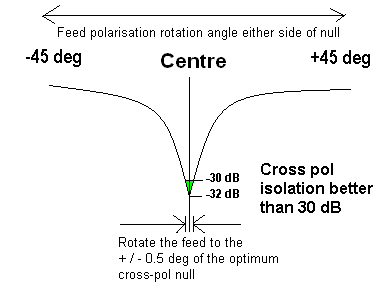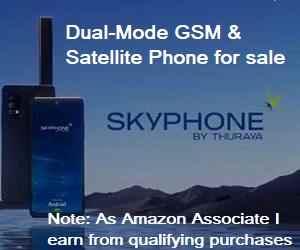If you are using linear polarisation, you need to turn the polarisation (rotation) angle of the feed so that the polarisation lines up with the angle of the satellite polarisation. This
dish pointing calculator works out the required polarisation angle.
The satellite operates on dual polarisation so it is critical that your angle is exactly adjusted to minimise interference into the opposite polarisation. The adjustment null is a very steep narrow notch, just one degree wide so adjustment must be done carefully and accurately.
Normally the hub (Intelsat) will ask you to transmit a CW carrier on some specific frequency and you will get under your feed arm and reach up and turn the feed in approx 1/2 or 1 deg intervals. At each step, wait 20 seconds while Intelsat measure the interference. Gradually they will talk you into the centre of the null.
Some modern VSAT antennas have a giant polarisation scale on the back of the dish and the entire dish is rotated to set the polarisation to 1 deg accuracy.
Where you have to adjust at the feed throat the tiny scales are inadequate for the accuracy needed. One solution is to hold an inclinometer sideways across the BUC or LNB. Another is to wrap a strip of paper round, measure the circumference C, calculate the require length = C x P /360 mm. Mark the angle and reattach the paper strip. Most times, with the feed throat method, you will need to adjust manually while on the phone to the hub. Be very patient with them as it takes the hub time to make each measurement.

If your polarisation error was 45 deg then your wanted signal would be reduced by half or 3 dB. You would also receive interference at the same level as your wanted signal, so your C/N=0 and no operation at all, for you and for someone else!.
Eutelsat and Astra satellite were not built with their polarisations aligned with the equator and the earth's axis, so you will always have to make manual corrections.
Read about
antenna polarisation adjustmentIf you make an error in your polarisation setting you interfere with other people's services, causing them intermittent or permanent loss of service. Very bad.
If you are using circular polarisation, as in C band, the quality of the polarisation isolation depends on the way the feed is designed and assembled. There is no adjustment angle needed. But you must assemble the feed correctly. Intelsat will still want to check the polarisation isolation however as you may have dropped washer inside and that is quite sufficient to mess things up. Take great care not to strain and bend the long polariser, which must be straight to about 0.001 inch. The flanges between the horn and the polariser must be exactly parallel all round. If there is a rubber O ring, tighten all the screws evenly.
Regards, Eric.



